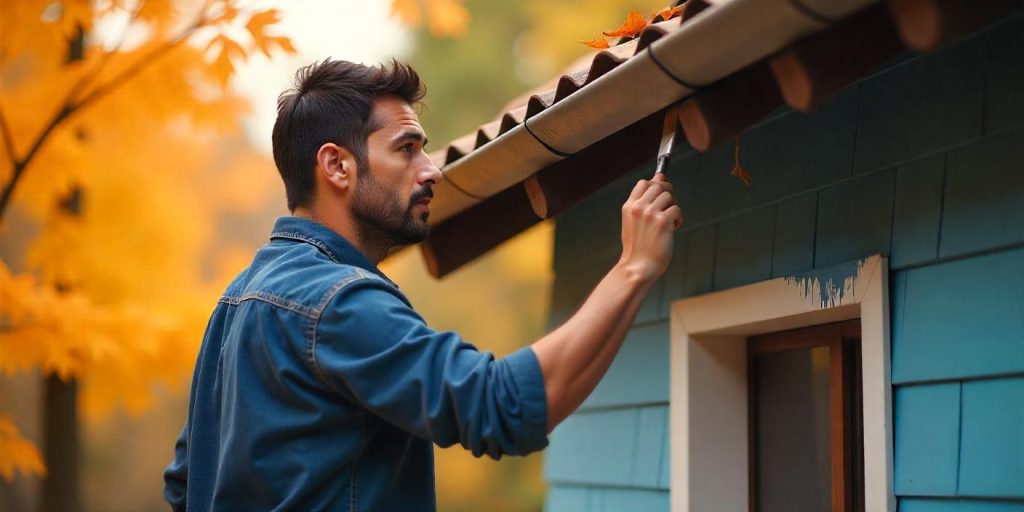Painting eaves is an essential task to protect your home’s exterior and maintain its curb appeal. Eaves are exposed to harsh weather conditions, which can cause paint to peel or wood to rot over time.

By painting your eaves, you not only enhance the appearance of your home but also extend the lifespan of these critical areas. This step-by-step guide will walk you through the process to achieve professional-looking results.
Contents
Why Painting Eaves Is Important
Protection Against Weather
Eaves are constantly exposed to sun, rain, and wind. A fresh coat of paint acts as a barrier against these elements, preventing damage.
Enhancing Aesthetics
Well-painted eaves improve the overall appearance of your home, adding to its value and curb appeal.
Preventing Wood Rot
Old or peeling paint can leave wood exposed to moisture, which can lead to rot. Painting seals the wood and protects it from damage.
Tools and Materials You’ll Need
- Ladder
- Drop cloths or tarps
- Sandpaper (medium and fine grit)
- Scraper or putty knife
- Paintbrushes (angled brushes for precision)
- Paint roller (optional)
- Painter’s tape
- Exterior primer
- Exterior paint (preferably weather-resistant)
- Caulk and caulk gun
- Safety gear (gloves, goggles, and a dust mask)
Preparing to Paint Eaves
Inspect the Eaves
Before starting, check the eaves for any signs of damage such as cracks, rot, or peeling paint. Address any structural issues before painting.
Gather Safety Equipment
Working on eaves often involves climbing ladders. Ensure your ladder is stable and placed on level ground. Use safety gear like gloves and goggles.
Choose the Right Weather
Paint on a dry day with mild temperatures. Avoid painting in direct sunlight or during high humidity, as these conditions can affect paint adhesion and drying.
Step-by-Step Guide to Painting Eaves
Step 1: Prepare the Area
- Lay down drop cloths or tarps to protect the ground, walls, and plants.
- Use painter’s tape to mask off areas you don’t want to paint, such as gutters and siding.
Step 2: Clean the Eaves
- Remove dirt, cobwebs, and debris using a broom or a pressure washer.
- Allow the eaves to dry completely before proceeding.
Step 3: Scrape and Sand
- Scrape off any loose or peeling paint using a scraper or putty knife.
- Sand the surface with medium-grit sandpaper to remove rough patches, then finish with fine-grit sandpaper for a smooth surface.
- Wipe away dust with a damp cloth.
Step 4: Repair Any Damage
- Fill cracks or gaps with exterior-grade caulk.
- Use wood filler to repair holes or damaged areas.
- Allow repairs to dry completely, then sand smooth.
Step 5: Apply Primer
- Use a high-quality exterior primer to ensure the paint adheres properly.
- Apply the primer evenly using a paintbrush or roller, depending on the size of the area.
- Let the primer dry according to the manufacturer’s instructions.
Step 6: Paint the Eaves
Using a Brush
- Use an angled paintbrush for precision on edges and corners.
- Apply paint in long, even strokes to prevent visible brush marks.
Using a Roller
- For larger areas, use a roller for quicker application.
- Backbrush immediately after rolling to ensure even coverage and avoid streaks.
Step 7: Apply a Second Coat
- Allow the first coat to dry completely.
- Apply a second coat for durability and a uniform finish.
Step 8: Remove Painter’s Tape
- Carefully peel off the painter’s tape before the paint fully cures to prevent peeling.
- Touch up any areas as needed.
Tips for Success
Work in Sections
Painting eaves can be time-consuming. Divide the area into smaller sections and complete one at a time to ensure consistent results.
Use High-Quality Paint
Invest in weather-resistant exterior paint for long-lasting results. Look for paints specifically formulated for wood or metal, depending on your eaves’ material.
Mind the Ladder
Safety is paramount when painting eaves. Ensure the ladder is positioned securely and do not overreach. Consider using an extension pole for hard-to-reach areas.
Maintaining Painted Eaves
Regular Inspections
Check your eaves annually for signs of peeling paint or damage. Address issues promptly to prevent further deterioration.
Clean Periodically
Remove dirt and debris from the eaves to keep them looking fresh and prevent buildup that can cause damage.
Repaint as Needed
Depending on weather conditions and the quality of paint used, you may need to repaint your eaves every 5–7 years.
Frequently Asked Questions
Can I paint eaves without using a ladder?
For single-story homes, you might be able to use an extension pole. However, for multi-story homes, a ladder is typically necessary.
What type of paint is best for eaves?
Use a weather-resistant exterior paint. Acrylic latex paint is a popular choice for its durability and ease of application.
How do I handle mold or mildew on eaves?
Clean the affected areas with a solution of water and bleach (3:1 ratio) before painting. Ensure the surface is thoroughly dry before applying primer and paint.
Final Thoughts
Painting eaves might seem like a daunting task, but with the right tools, preparation, and techniques, it’s a manageable DIY project. By following this step-by-step guide, you can protect your home from the elements, enhance its aesthetic appeal, and save money on professional services.
Take your time, focus on safety, and enjoy the satisfaction of transforming your home’s exterior with a fresh coat of paint.
